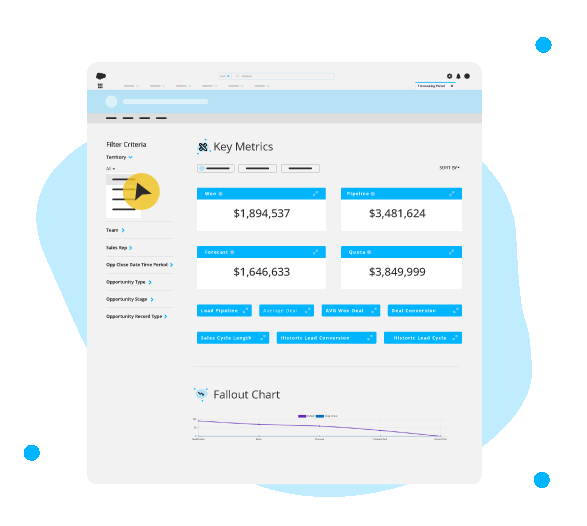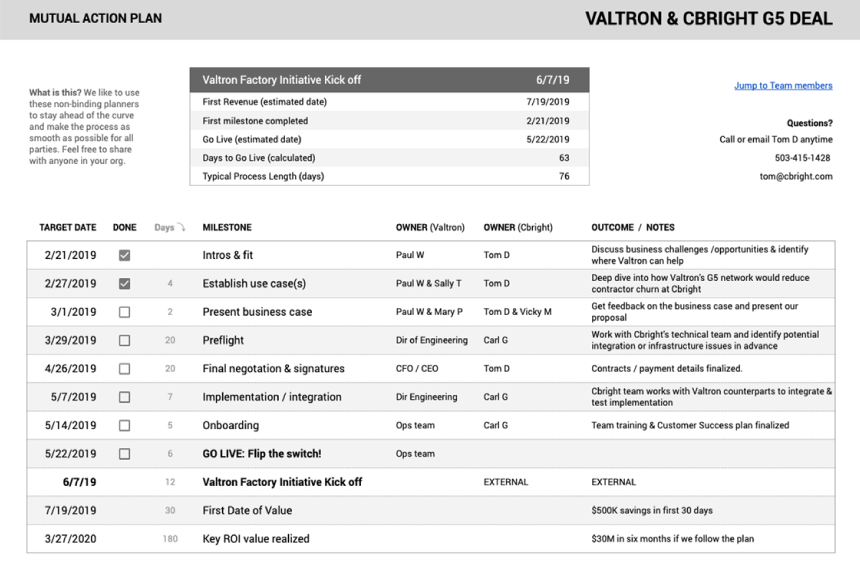Gartner has reported that more than half of sales leaders do not have high confidence in their forecasting accuracy. Why? It is because sales leaders are having to forecast with inaccurate or incomplete data the majority of the time. One issue is sales reps not keeping their pipeline up-to-date, another comes from forecasting with a bloated pipeline.
In our eBook, How to Achieve Accurate & Actionable Forecasting Data, we defined a bloated pipeline as “when you have a large number of opportunities open that are not viable deals, or you have a high percentage in the commit category, but then only a small portion of them actually close.” A bloated pipeline can kill your forecasting accuracy, which is why it is so important to coach your reps on good habits to avoid this from happening.
❶ Encourage your team to use mutual action plans
Coaching your sales team to get aligned with their prospects on the level of urgency, timeline, and close date for an opportunity is critical. It is when misalignment happens that a bloated pipeline can start. An Account Executive may think a deal is going to close in two weeks when in reality the prospect is not anywhere near ready to sign that soon.
Forecasting categories can be used to get a better sense of which deals are expected to close this month and which deals are losing momentum or dead. Founder & CEO, Craig Jordan shared on a fireside chat that he likes to use four categories, pipeline, commit, omit, and won (fig 1).

Mutual action plans are steps and timelines agreed upon by the buyer and the seller for how the deal cycle is going to be conducted. The major milestones and the parties involved are identified and everyone is aware and aligned to the close date they are aiming for, so they can achieve project or implementation kick-off by a certain date (fig 2).
Figure 2, Example of a Mutual Action Plan. Source: Sales Hacker
This technique makes it super clear to both the buyer and the seller of what is expected. It also helps the sales rep to understand the buyer’s level of urgency and their timeline for being able to get approval and the contract signed. The seller can then categorize the deal appropriately in the pipeline or commit category once they know how soon the deal will close.
When there is a mutual action plan in place, the buyer is less likely to ignore or “ghost” the rep because they have agreed to the timeline and they know the implications that will occur if there is a delay on their end, such as a hinder in project or implementation kick-off.
This method makes it super clear to the Account Executive (AE) whether or not this is a viable deal and if it should be counted because otherwise it is only contributing to a bloated pipeline and should be moved to the omit category.
❷ Track when close dates are getting pushed out on opportunities
It is natural for a sales rep to need to push out a close date on a deal, however, if they do this ten times, then there should be a question of whether or not it is actually going to happen. If it is not, then it is only bloating your pipeline.
You can use timestamp fields on your opportunities to track when the close date was changed, using a custom date field such as original close date to then measure the delta between the original and when it actually closes. You can also have your sales managers receive notifications on when sales reps are changing close dates in their pipeline, so they are made aware.
If an AE keeps pushing the close date of an opportunity further into the future, then it could be time for them to question whether or not they need to let go. Letting go can be extremely difficult especially if they were working the deal for a long time, but moving on can empower them to focus on other opportunities that could yield actual revenue for the business.
The below questions have been included as a resource to share with sales teams for them to do a gut check on whether or not they should keep pursuing a deal when they keep having to move the close date further into the future.

-
-
-
- Is there a true urgency to meet the need or fix the challenge that our solution provides?
- Do I have access to the right buying authority?
- Have I understood what the real priorities of the buyer are and I have aligned our solution to the right challenges?
- Are there other members from their team that need to be involved to push this through that I have not engaged yet?
- Is the buyer responsive or do they keep ignoring me?
- How many times have I reached out and gotten no response?
-
-
Consider how you can have parameters in place that can help guide sales reps on when they should kill off a deal, so that it does not bloat your pipeline. This will help them to confidently know when they need to let go.
❸ Activate champions within your sales organization
Depending on the size of your sales team, you may not be in the trenches with your reps that you are trying to coach and mold on a daily basis. You may only see them once a week or once a month. If that is the case, aligning with champions in your organization that are closer to the trenches with your sales team can help to better achieve and enforce what you are trying to accomplish, such as good judgment on when to place a deal in the omit or commit category.

Coaching your team and enforcing these good habits is better accomplished when you have sales champions that are experienced, who can be leaders modeling good behavior and best practices to other sales reps that are newer, less experienced, or may just be missing the mark on some of their habits.
Using mutual action plans, tracking when close dates are getting pushed out on opportunities, and activating your sales champions within your organization can all help avoid having a bloated pipeline. Using these three techniques in conjunction with forecasting categories, standardized probability, and forecasting your net versus your gross can all contribute to achieving accurate forecasting.
Sales Forecasting for Revenue Growth




